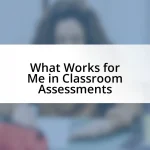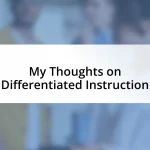Key takeaways:
- Critical thinking skills involve questioning assumptions and recognizing biases, empowering students to make informed decisions and engage deeply with complex issues.
- Effective teaching strategies include the Socratic method, problem-based learning, and reflective practices, promoting rich dialogue, collaboration, and self-awareness.
- Assessing critical thinking can be conducted through informal discussions, written reflections, and peer evaluations, revealing insights into student growth and understanding.
- Integrating critical thinking into the curriculum should be organic, using real-world applications and interdisciplinary connections to foster student engagement and empowerment in their communities.

Understand Critical Thinking Skills
Understanding critical thinking skills is like opening a door to deeper learning. It’s not just about analyzing information; it’s about recognizing biases and questioning assumptions, which was a real eye-opener for me during my first teaching experience. Have you ever found yourself simply accepting a fact without questioning its source?
One time, while facilitating a group discussion, a student confidently stated a popular opinion. Instead of correcting them outright, I encouraged the class to consider alternative viewpoints and the evidence behind those views. This moment highlighted how critical thinking isn’t just about right or wrong answers; it’s about the journey of inquiry and exploration.
I’ve come to realize that critical thinking empowers learners to make informed decisions. It’s fascinating to see how tapping into these skills can transform a student’s confidence, allowing them to engage more deeply with complex issues. Don’t you find it rewarding when students begin questioning not just what they learn, but why?

Importance of Teaching Critical Thinking
Teaching critical thinking is essential in today’s rapidly changing world. It enables students to sift through the vast amounts of information they encounter daily, fostering an ability to discern credible sources from unreliable ones. I remember a moment when a student shared a sensational article on social media that turned out to be misleading. Instead of simply addressing the misinformation, I guided the entire class in a discussion on how to evaluate sources, a skill that proved invaluable beyond that single instance.
- Critical thinking nurtures independence in decision-making, preparing students for real-life challenges.
- It encourages collaboration and dialogue, cultivating a classroom environment where diverse perspectives are welcomed.
- Engaging in critical analysis fuels creativity, allowing students to approach problems from various angles.
- By teaching critical thinking, we lay the groundwork for future leaders who can tackle complex issues with confidence.
This shift in understanding not only benefits students academically; it instills a sense of empowerment that resonates throughout their lives. I’ve witnessed firsthand how the ability to question and analyze transforms students from passive recipients of knowledge into curious explorers of the world around them.

Strategies for Teaching Critical Thinking
There are several effective strategies for teaching critical thinking that I’ve found valuable in my own experience. One approach is the Socratic method, where I pose open-ended questions that challenge students to think deeply and articulate their reasoning. This method encourages a rich dialogue that often results in unexpected insights and perspectives. I recall a robust discussion where a simple question sparked a debate that illuminated multiple viewpoints on a controversial topic, showcasing how critical engagement can lead to learning that feels organic and relevant.
Another strategy I enjoy employing is problem-based learning, where students tackle real-world issues or scenarios. By presenting students with genuine challenges, I see them collaborate, brainstorm, and evaluate different solutions. This method not only enhances critical thinking but also cultivates teamwork and communication skills. One memorable project involved students developing a sustainable initiative for our school, which led to passionate discussions and innovative ideas that surprised even me!
Additionally, integrating reflective practices, such as journaling or group reflections, allows students to think about their thinking. I often find that revisiting their thought processes helps them to identify biases or gaps in their understanding. During one journaling session, a student expressed how their perspective had shifted after considering opposing views in class—this realization highlighted the profound impact of reflection on developing critical thinking skills.
| Strategy | Description |
|---|---|
| Socratic Method | This technique emphasizes dialogue and questioning to deepen understanding. |
| Problem-Based Learning | Students collaborate on real-world problems, enhancing both critical thinking and teamwork. |
| Reflective Practices | Engaging students in reflection through journaling helps them recognize and re-evaluate their thought processes. |

Assessing Critical Thinking Development
Assessing the development of critical thinking in students can be both challenging and insightful. I’ve often used informal assessments, like class discussions, to gauge students’ ability to articulate their reasoning. For example, during a debate on ethical dilemmas, I discovered that the students who initially seemed quiet were often the ones providing the most profound insights, prompting me to reconsider how I evaluate their contributions.
To get a clearer picture of individual progress, I also opt for written reflections. This method gives students a chance to express their thoughts in words, revealing their understanding and the complexity of their reasoning. I remember one student’s reflection after a group project—she elegantly connected her personal values to the ethical implications of their findings, demonstrating a growth in both critical thinking and self-awareness. How often do we overlook the subtleties in their expressions that can tell us so much about their growth?
Finally, utilizing peer evaluations adds another layer to the assessment process. I encourage students to critique each other’s arguments in writing, which not only helps them analyze different viewpoints but also fosters a deeper understanding of their own. Once, in a peer review session, a student hesitated to challenge a classmate’s argument, but when she did, it opened up a meaningful dialogue that enriched the entire classroom experience. Isn’t it fascinating how feedback can spark transformative conversations?

Integrating Critical Thinking into Curriculum
Integrating critical thinking into the curriculum is crucial, yet I’ve found that it needs to be woven in naturally, rather than being a mandatory checklist. I remember when I redesigned a history unit around inquiry-based projects. Instead of just memorizing dates, students researched historical figures’ decisions and the consequences of those choices. The discussions that sprang from their presentations were lively and deeply analytical, proving that when students have a stake in their learning, critical thinking flourishes organically.
I also like to create interdisciplinary connections that encourage critical thinking from multiple perspectives. For instance, during a science lesson on climate change, I partnered with the arts department to have students create multimedia projects. One group developed a compelling video that argued for sustainable practices using data and emotional storytelling. Watching them connect facts with creativity was eye-opening; it highlighted how critical thinking can emerge from various disciplines when teachers collaborate beyond their silos.
Another effective technique I’ve implemented involves real-world application through service learning. I once facilitated a project where students designed a community outreach initiative to address local food insecurity. This not only required them to analyze socio-economic factors but also demanded empathy and understanding. Observing their growth as they navigated challenges, I was reminded of how critical thinking is not just an academic exercise—it’s a vital skill that shapes how students engage with their community and the world at large. Isn’t it powerful to see education extend beyond the classroom walls?

Overcoming Challenges in Teaching
Teaching comes with its fair share of challenges, and I’ve often encountered resistance from students who feel unsure about voicing their opinions. I recall a time when a particularly shy student surprised me by raising her hand during a brainstorming session. She articulated her thoughts with such clarity that it compelled others to join in the conversation. It made me realize that creating an environment where every voice matters can truly transform classroom dynamics. How many potential ideas go unshared simply because a student feels discouraged?
Another hurdle I’ve faced is finding the balance between guiding students’ learning and giving them the freedom to explore. During a project on local history, I initially took a hands-on approach, mapping out every detail. However, I quickly recognized that students thrived when I eased my grip, allowing them to navigate their inquiries. In doing so, I witnessed moments of authentic discovery as they dove deeper into their research. Isn’t it enlightening to see that sometimes, stepping back can propel students forward?
Perhaps the most significant challenge is overcoming the ingrained fear of failure. I once introduced a “failure feedback loop” exercise where students shared their mistakes and the lessons learned. The vulnerability displayed during these discussions opened new avenues for growth and fostered trust among peers. I’ve seen firsthand that normalizing setbacks not only enhances critical thinking but also builds resilience. Doesn’t embracing failure as a part of the process empower students to take real intellectual risks?

Resources for Enhancing Critical Thinking
To enhance critical thinking, I’ve found that leveraging diverse resources can significantly elevate students’ engagement and analytical skills. Books like “The Critical Thinking Toolkit” have been game-changers for my classroom discussions. They provide practical strategies and exercises that prompt students to challenge their assumptions and delve deeper into subjects, fostering a culture of inquiry. Have you ever noticed how a single resource can ignite a spark in learners?
Technology also plays a vital role. Online platforms, such as Socratic questioning forums, allow students to engage in debates and discussions outside classroom hours. I often witnessed my students using these platforms to deepen their understanding by posing questions and encountering different viewpoints. It’s fascinating how this additional layer of dialogue can shift their perspectives. Have you experienced similar benefits using technology in your teaching?
Lastly, I emphasize the importance of using multimedia resources, like TED Talks, which not only inspire but also serve as springboards for critical analysis. I remember screening a talk on artificial intelligence that led to a spirited discussion about ethics and future implications. The excitement in the room was palpable as students shared their thoughts and challenged each other’s ideas. Doesn’t it feel rewarding to watch students connect concepts in such dynamic ways?














